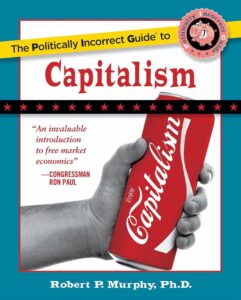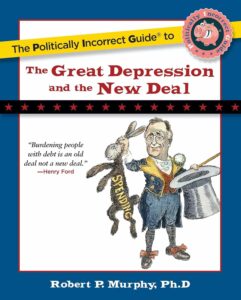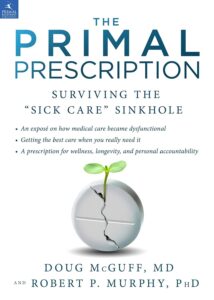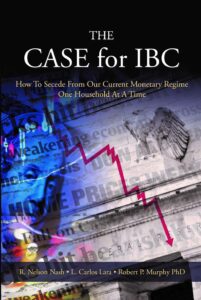Potpourri
* My critique [.pdf] of William Nordhaus’ “DICE” model (arguing for a carbon tax) in The Independent Review is now online. Also of interest is Dan Shahar’s article (summary here) in the same issue on “Climate Change and Justice.”
* Speaking of climate change, here’s an odd post where Joe Romm excoriates the Saudis for charging too high oil prices over the years, and thereby hurting consumers. I skimmed the article, but not one word that I saw about, “Oh by the way, in my view this charging of monopoly prices probably spared millions of deaths worldwide, but their motives were wrong so that’s why I’m mad.”
* Von Pepe sends this post where Casey Mulligan explains that TARP should have been expected to lead to less lending, a conclusion that an official study has recently confirmed. I guess the guys who challenged me on Kudlow weren’t aware of these things. I should have countered their “factual” a little more strongly.
Taking a Random Walk
Many experts will tell you to stop studying the economy and the markets, that the best thing to do is “buy and hold.” Apropos that advice:
Congratulations investors. The Dow has hit 10,000 on October 14th, 2009. You now have made officially 0 percent return if you invested in this index when the Dow first hit this magical level in 1999.
Free Free Advice
In response to numerous complaints, I have removed the one remaining Google ad from the left margin. Please tell me if that solves the problem of ads blocking the text.
If that does the trick, I’m happy to leave things like this for a while. I will adopt the strategy of drug dealers on government-produced commercials. “Give it to them for free at first, get them hooked, and then start charging them.”
When the readership grows to the point where it would “pay for itself,” I will hire a professional to totally revamp the blog and put back in ads–but only if it’s done tastefully. I have my standards.
BLS Reports a Modest Increase in CPI for September
Well, I purposely went on record yesterday before seeing the numbers, so that I could have some semblance of objectivity. I said, “If it’s relatively tame, then I think Bernanke will have successfully tamed the domestic inertia in prices.”
Today the BLS reports that the actual CPI went up 0.1% from August to September, and after seasonal adjustment they report it as a 0.2% hike. It’s still very misleading for people to cite year/year changes and say “we’re still experiencing deflation,” as this picture indicates.
It’s also possible that the BLS is fiddling with their method in order to keep the numbers tame. But obviously if I am warning people about the potential for double-digit price inflation, I shouldn’t have to rely on these possibilities. So, until something changs, I will concede that Bernanke seems to have succeeded in pumping in all those new reserves without lighting an inflationary firestorm on the domestic front. (There is still the wildcard of foreign demand.)
Middle East Map Fun!
I am knowledgeable in many diverse fields, but one of my obscenely blind spots is geography. I am not kidding, once in Hillsdale (as a student) we had a map quiz for a history class. There was a map of the US that didn’t have the state names; I can’t remember if the borders were noted. In any event, I tried to be funny and put “Lake Baw Beese” on the map (named after an Indian chief who lived in the area before the Michigan authorities made a perfectly legitimate real estate transaction, I’m sure). I think I got a 60% on the quiz, and the professor noted that I had placed Lake Baw Beese in Illinois, not Michigan.
With that preamble, it occurs to me that maybe some Free Advice readers are similarly inept when it comes to the Middle East. So here ya go, to help you make sense of all the news stories:

(Map source)
Some observations:
(1) The borders of Kuwait were not exactly determined through Lockean principles. Do you think Saddam Hussein minded that his access to the Persian Gulf was [almost] completely blocked? I think Walter Block has written essays on this kind of thing, in the context of private roads…
(2) Imagine you are the leader of Iran. When you’re not busy refining uranium, you pay attention to what the United States government is doing. After 9/11 they invade and occupy Afghanistan, in order to defend the US. Then they invade and occupy Iraq, in order to defend the US. They have Predator drones patrolling Pakistan, and US troops occasionally cross the border to hunt down terrorists–to defend the region and the US. They already have bases established in Kuwait. They have an air base in Turkey. If you were a paranoid sort–and I bet all those imperialist Iranian leaders are, it’s just like them–you’d start to smell a rat. You’d probably really get worried if the talks about a US base in Azerbaijan ever went anywhere. (You would have been quite relieved–phew!!–when the US ambassador announced in 2005 that there were no plans to relocate a military base to Turkmenistan.)
(3) So, who’s surprised that all of our military honchos and hawkish pundits keep telling us how dangerous Iran is?
The $850 Billion Question
You know how a few months after you first get a GPS system in your car, you no longer can find your way to the grocery store on your own? Well that’s what Robert Wenzel’s site EPJ has done to me, in terms of staying abreast of the government’s financial shenanigans.
In this post Wenzel reproduces some very scary quotes from the Federal Open Market Committee, and how they are making it a “top priority” to develop “tools” to withdraw the excess liquidity from the financial system before all hell breaks loose (I’m paraphrasing). Let’s remind ourselves what all the fuss is about:

Right now, the banks have the legal ability (i.e. they can still satisfy their reserve requirements) to lend out some $850 billion in new loans in step one. But then remember we are in a fractional reserve system, so as that initial burst of lending gets deposited back, a second (and smaller) wave of new lending could occur. Using a back-of-the-envelope 10% multiplier, there are enough excess reserves in the system to support a total of $8.5 trillion in new loans.
In practice that is too much; let’s be conservative and call it a mere 5 trillion new US dollars in the wallets and checking account balances of the public. How much is that? Well right now M1 (basically cash held by the public, checking accounts, travelers’ checks, and other really liquid assets) is about $1.65 trillion. So an injection of an additional $5 trillion would mean a quadrupling of the narrow “money supply” held by the public. So if gas costs $2.50 a gallon right now, it would cost $10 a gallon when everything settled down.
Ah, but this assumes the worldwide demand to hold dollars stays constant, which it surely would not in such an environment. I emailed back and forth with Jeff Hummel a few months back, and we came to the (very rough) conclusion that if the worldwide demand to hold dollars fell in half, that would be akin to a 30% increase in the domestic money stock (using the current levels, not the uber-inflated one). So let’s round it off to $11 / gallon gasoline.
The thing is, it doesn’t matter what Bernanke et al.’s plans are to make interest on reserves. If and when price inflation starts getting out of control, the banks aren’t going to sit idly by while the dollar crashes. It’s no good to have $850 billion in reserves on deposit with the Fed–rolling over at 0.25% APR–if CPI is rising at 3% per month and yields on 10-year Treasurys have risen to double-digits. Sure, Bernanke could jack up the interest he pays on reserves, but that just makes the problem grow exponentially. At some point, even Wall Street analysts will have to realize that the only point to having a stockpile of US dollars is that you spend (at least some of) them.
Of course, the real question for investors is the timing. Is Bernanke’s delicate balancing act going to keep up for several years, or will it come crashing down before Christmas? A few months ago, I thought the collapse was imminent. I couldn’t believe that investors worldwide would continue to buy the US Treasury’s garbage (literally) at such high prices for much longer.
But I must confess I have been surprised by the relatively tame CPI reports. It’s true, price inflation is positive, even though people keep repeating the mantra that we’re in a deflationary black hole. But the big spikes in M1 and M2 in late 2008 have basically been tamed by Bernanke holding them constant since then.
So for me, I’m very curious to see tomorrow’s scheduled CPI release (for the August–>September price hikes). If it’s relatively tame, then I think Bernanke will have successfully tamed the domestic inertia in prices. But if it’s a big “unexpected” spurt, then I will still maintain that things are slipping out of control for our overlords in DC very quickly.
Finally, I reiterate my view that at any time, the dollar could crash against other currencies based on some slip of the tongue by a foreign central banker. In that scenario, oil shoots up to $175 or higher in a day, and those of you who bought gold and silver coins based on this blog will owe me a Christmas card. (And yes I recognize that my overall views here are strikingly similar to those I earlier mocked when voiced by Robert Wenzel.)
Robert Reich’s Straight Talk on Health Care Reform
Clinton Labor Secretary Robert Reich gives us the lowdown on how he (and presumably his buddies in the Obama Administration?) really think about things, when they don’t have pesky political considerations to worry about. The beginning gives you the context. Be sure to hang in there, trust me you will want to hear what Reich has to say. Reich delivered these remarks at UC Berkeley on September 26, 2007.
Did Bernanke Really Fix the Banking Problem?
The quixotic Von Pepe and I have been discussing the fact that Bernanke has quite literally papered over the huge problems in the banking sector. We both expect not merely another “dip” but a full-blown crash at some point. (I think it could happen any day, but I don’t want to put words in Von Pepe’s mouth.) I came across this chart and thought it illustrated our viewpoint quite nicely:

This is another great example of Fed charts as fine art. I think I could hand this picture out to 100 financial analysts and economists, ask for an interpretation, and get 100 different answers. Then, five years from now, we would look back and realize at least one of the respondents had nailed it. And I don’t think the winning entry would have begun, “Bernanke eased the credit crunch by providing desperately needed liquidity, thereby sparing the economy from a painful adjustment process in light of the bad loans made during the housing boom.”







Recent Comments